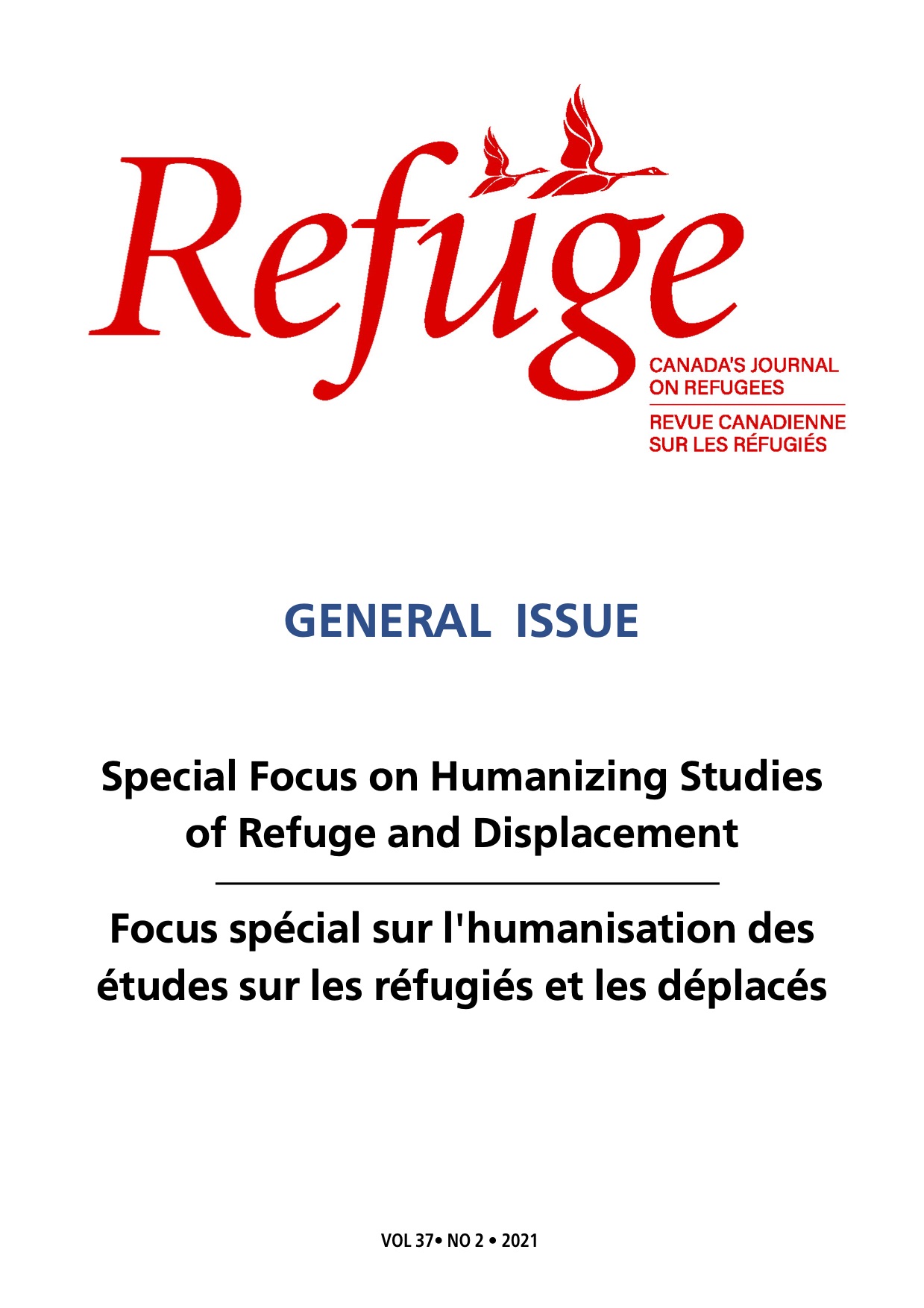Soutenir sa famille en contexte de migration forcée en tant que femme syrienne établie au Québec et au Liban
entre vulnérabilités et responsabilités ambivalentes
DOI:
https://doi.org/10.25071/1920-7336.40765Keywords:
refugee women, family support, vulnerability, transnational feminism, Syria, Lebanon, QuébecAbstract
Although the vulnerability of refugee women is a cornerstone of access to protection, it is rarely defined beyond its common-sense meaning - the risk of suffering harm. This article presents the results of an empirical research where 12 life histories were collected from Syrian refugee women responsible for supporting their families in Lebanon (7) and Québec (5). The analysis mobilized the concept of ambivalent vulnerability (Oliviero, 2016) and showed that women and their relatives were certainly exposed to forms of adversity, but also to transformative opportunities and to elements of continuity with their life trajectories.
Metrics
References
Akesson, B. et K. Coupland. (2018). Without choice? Understanding war-affected Syrian families’ decisions to leave home. International Organization for Migration (IOM) Migration Research Series, 54.
Asal, H. (2016). Se dire Arabe au Canada. Un siècle d’histoire migratoire. Presses de l’Université de Montréal.
Atak, I., D. Nakache, E. Guild et F. Crépeau. (2018). ‘Migrants in vulnerable situations’ and the Global Compact for Safe Orderly and Regular Migration. Queen Mary University of London School of Law Legal Studies Research Paper, no 273.
Bertaux, D. (2010). L’enquête et ses méthodes. Le récit de vie (3e édition). Armand Colin.
Blain, M.-J., Rodriguez del Barrio, L., Caron, R., Rufagari, M.-C., Richard, M., Boucher, Y. et Lester, C. (2019). Expériences de parrainage collectif de personnes réfugiées au Québec : perspectives de parrains et de personnes réfugiées de la Syrie. Lien social et Politiques, (83), 204-229. https://doi.org/10.7202/1066091ar
Brown, K., K. Ecclestone et N. Emmel. (2017). The many faces of vulnerability. Social Policy & Society, 16(3), 497-510. https://doi.org/10.1017/S1474746416000610
Butler, J. (2012). Precarious Life, Vulnerability, and the Ethics of Cohabitation. The Journal of Speculative Philosophy, 26(2), 134-151. https://doi.org/10.5325/jspecphil.26.2.0134
Butler, J., Z. Gambetti et L. Sabsay (dir.). (2016). Vulnerability in resistance. Duke University Press.
Caron, R. (2012). Entre refuge et exil. L’expérience de femmes palestiniennes du camp de Bourj el Barajneh [Thèse de doctorat]. Université de Montréal.
Caron, R. (2017-2020). « Femme, Syrienne et réfugiée : être et devenir. Perspective transnationale sur les appartenances et les parcours identitaires de femmes réfugiées syriennes au Québec et au Liban », Projet de recherche, Centre de recherche et de partage des savoirs CIUSSS du Nord-de-l’Île-de-Montréal, Université de Montréal.
Caron, R., D. Damant et C. Flynn. (2017). Des récits de réfugiées palestiniennes à travers la grille de l’intersectionnalité. Recherches féministes, 30(1), 183-199. https://doi.org/10.7202/1040981ar
Chatel, V. et S. Roy (dir.). (2008). Penser la vulnérabilité. Visages de la fragilisation du social. Presses de l’Université du Québec.
D’Cruze, S. et A. Rao. (2004). Violence and the Vulnerabilities of Gender. Gender & History, 16(3), 495-512. https://doi.org/10.1111/j.0953-5233.2004.00353.x
Denov, M., Fennig, M., Rabiau, M. A. et Shevell, M. C. (2019). Intergenerational resilience in families affected by war, displacement, and migration: “It runs in the family”. Journal of Family Social Work, 22(1), 17-45. https://doi.org/10.1080/10522158.2019.1546810
Denov, M. et Shevell, M. C. (2019). Social work practice with war affected children and families: the importance of family, culture, arts, and participatory approaches. Journal of Family Social Work, 22(1), 1-16. https://doi.org/10.1080/10522158.2019.1546809
Desmarais, D. (2009). L’approche biographique. Dans B. Gauthier (dir.), Recherche sociale. De la problématique à la collecte des données (5e éd., pp. 361-389). Presses de l’Université du Québec.
Eastmond, M. (2007). Stories as Lived Experience: Narratives in Forced Migration Research. Journal of Refugee Studies, 20(2), 248-264. https://doi.org/10.1093/jrs/fem007.
Freedman, J. (2017). Women’s experience of forced Migration. Gender-based forms of insecurity and the uses of “vulnerability”. Dans J. Freedman, Z. Kivilcim et N.O. Baklacıoğlu (dir.), A gendered approach to the Syrian Refugee Crisis (pp. 125-141). Routledge.
Garnier, A., L.L. Jubilut et K. B. Sandvik (dir.). (2018). Refugee resettlement. Power, politics and humanitarian governance. Berghahn Books.
Ghorashi, H. (2008). « Giving Silence a Chance: The Importance of Life Stories for Research on Refugees ». Journal of Refugee Studies, 21(1), 117-132. https://doi.org/10.1093/jrs/fem033.
Gilson, E. C. (2014). The Ethics of Vulnerability. A Feminist Analysis of Social Life and Practice. Routledge.
Gouvernement du Liban et Nations Unies. (2019). Lebanon Crisis Response Plan 2017-2020. https://data2.unhcr.org/en/documents/download/67780.
Grace, B.L. (2018). Family from Afar? Transnationalism and Refugee Extended Families After Resettlement. Journal of Refugee Studies, 32(1), 125-143. https://doi.org/10.1093/jrs/fey019
Guillaumin, C. (1972). L’idéologie raciste. Genèse et langage actuel. Institut d’études et de recherches interethniques et interculturelles.
HCR. (2021a). Syria emergency. https://www.unhcr.org/syria-emergency.html.
HCR. (2021b). COVID-19 pandemic worsening gender inequalities for refugee women and girls. ttps://www.unhcr.org/neu/52701-covid-19-pandemic-worsening-gender-inequalities-for-refugee-women-and-girls.html.
HCR. (2014). Woman Alone. The fight for survival by Syria’s refugee women. https://www.unhcr.org/ar/53bb8d006.pdf.
HCR. (2008). Manuel pour la protection des femmes et des filles. https://www.unhcr.org/fr/protection/women/4c8f3fd96/manuel-hcr-protection-femmes-filles.html.
HCR, Unicef et PAM. (2019). VASYR 2019: Vulnerability Assessment of Syrian Refugees in Lebanon. https://data2.unhcr.org/en/documents/details/73118.
Janmyr, M. et L. Mourad. (2018). Categorising Syrians in Lebanon as ‘Vulnerable’. Forced Migration Review, (57), 19-21. http://www.fmreview.org/syria2018
Le Blanc, G. (2011). Que faire de notre vulnérabilité ?. Bayard.
Le Gall, J. (2001). La participation des femmes au processus de migration transnationale familiale: le cas des Shi'ites libanais à Montréal [Thèse de doctorat], Université de Montréal.
Madziva, R. (2016). Transnational parenthood and forced migration: the case of asylum-seeking parents who are forcibly separated from their families by immigration laws. Families, Relationships and Societies, 5(2), 281-297. https://doi.org/10.1332/204674315X14479281723965
McLaren, M. (dir.). (2017). Decolonizing feminism. Transnational feminism and globalization. Rowman & Littlefield.
Mohanty, C.T. (2003). Feminism Without Borders. Decolonizing Theory, Practicing Solidarity. Zubaan.
Nicholson, F. (2018). The “Essential Right” to Family Unity of Refugees and Others in Need of International Protection in the Context of Family Reunification. UNHCR. http://www.unhcr.org/protection-policy-and-legal-advice.
OIM. (2018). World Migration Report 2018. https://www.iom.int/wmr/world-migration-report-2018.
Oliver, K. (2017). The special plight of refugee women. Dans M.A. McLaren. (dir.). Decolonizing Feminisms. Transnational Feminisms and Globalization. Rowman & Littlefield.
Oliviero, K.E. (2016). Vulnerability’s Ambivalent Political Life: Trayvon Martin and the Racialized and Gendered Politics of Protection. Feminist Formations, 28(1), 1-32. https://doi.org/10.1353/ff.2016.0013
Pierre, A. (2021). Empreintes de résistance. Filiations et récits de femmes autochtones, noires et racisées. Éditions du remue-ménage.
Richard, M. et Caron, R. (2020). Réalités (in)visibles et vulnérabilités ambivalentes : dialogue autoethnographique autour d’un terrain de recherche effectué auprès de femmes réfugiées au Liban. Nouvelles Perspectives en Sciences Sociales, 16(1), 145-179. https://doi.org/10.7202/1075858ar
Richard, M. (2019). Au-delà du sens commun : Reconsidérer la vulnérabilité des femmes réfugiées en provenance de Syrie détenant la responsabilité principale du soutien de leur famille au Québec et au Liban [Mémoire de maitrise]. Université de Montréal. https://papyrus.bib.umontreal.ca/xmlui/handle/1866/23700
Rohwerder, B. (2016). Women and girls in forced and protracted displacement. K4D Helpdesk Report. Brighton, UK: Institute of Development Studies. http://www.gsdrc.org/wp-content/uploads/2016/06/HDQ1364.pdf
Schmoll, C. (2020). Les damnées de la mer. Femmes et frontières en Méditerranée. La Découverte.
Soulet, M.-H. (2005). Reconsidérer la vulnérabilité. EMPAN, 4(60), 24-29.
Taha, D.M. (2020). “Like a tree without leaves”: Syrian refugee women and shifting meaning of marriage. Mashriq & Mahjar, 7(1). https://doi.org/10.24847/77i2020.245.
Vergès, F. (2018). Un féminisme décolonial. La fabrique éditions.
Westoby, P. et A. Ingamells (2010). A Critically Informed Perspective of Working with Resettling Refugee Groups in Australia. The British Journal of Social Work, 40(6), 1759-1776. https://doi.org/10.1093/bjsw/bcp084
Women’s Refugee Commission. (2017). Vulnerability and resilience-based approaches in response to the Syrian crisis: Implications for women, children and youth with disabilities. https://reliefweb.int/report/syrian-arab-republic/vulnerability-and-resilience-based-approaches-response-syrian-crisis.
Zeweri, H. (2017). The specter of failure: rendering Afghan women as sites of precarity in empowerment regimes. International Feminist Journal of Politics, 19(4), 441-455. https://doi.org/10.1080/14616742.2017.1303335
Published
Versions
- 2021-11-22 (3)
- 2021-12-30 (2)
- 2021-11-22 (1)
How to Cite
Issue
Section
License
Copyright (c) 2021 Myriam Richard

This work is licensed under a Creative Commons Attribution-NonCommercial 4.0 International License.
Refuge authors retain the copyright over their work, and license it to the general public under the Creative Commons Attribution-Non Commercial License International (CC BY-NC 4.0). This license allows for non-commercial use, reproduction and adaption of the material in any medium or format, with proper attribution. For general information on Creative Commons licences, visit the Creative Commons site. For the CC BY-NC 4.0 license, review the human readable summary.







